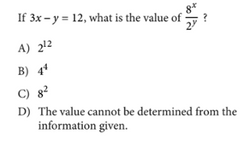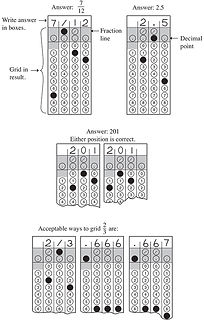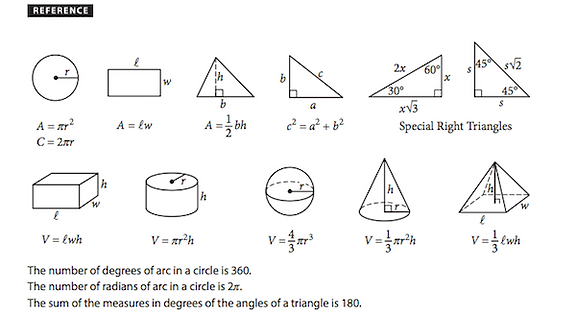
SAT topics/format
section 1: reading
Note: Move the photos on the right to get the example you want and double-click it.
 |
|---|
 |
 |
 |
 |
 |
 |
 |
 |
 |
Graphics
Two passages of the test will include an info-graphics- one is in the science passage and the other is in the social studies/history passage.
Question's format
Of the 52 questions:
-
10 will be vocabulary questions (2 per passage) which require you to understand the meaning of the word in context- see the example in the photos.
-
10 questions will be "command of evidence" questions (2 per passage) in which you have to decide which part of the passage supports a specific conclusion or backs up the answer choice of the previous question- see the example in the photos.
All of the reading questions on the new SAT directly test your skill at comprehending what you read, based on the evidence you find in the selected passage.
Unlike the math sections, questions are not necessarily arranged in order of difficulty; instead, they generally follow the organization of the passage on which they are based. for example, main idea questions are likely to appear at the beginning of the question set. question about accompanying information in graphics or contrasting questions are likely to be found at the end of the passages. these details help keep your pace yourself during the reading section.
section 2 : writing and language
 |
|---|
 |
 |
 |
 |
 |
 |
 |
 |
 |
 |
 |
 |
Passage types
One or two of the passages will be informative/explanatory text, one or two of the passage will be arguments, and one will be a narrative.
Graphics
One or two passages on your test will be accompanied by an info-graphic - a table, chart, graph, map, or some combination of graphics.
Question format
Of the 44 questions on your test:
-
24 will be about expression of ideas (improving the quality of the author's message).
-
20 will be about standard English conventions (grammar, usage, and mechanics).
8 questions will test your command of evidence (some with the info-graphics and some based on the text). Another 8 questions will test words in context (e.g., determining the correct "fit" given the rhetorical goal). The writing and language questions are in random order.
Note: double click the gallery for full screened photo
section 3 & 4: Math
non-calculator and calculator
Math Sections
The math part of the test has a total of 58 questions divided into two sections, each of which has its own format:
-
third section:
-
the 25-minutes section, during which calculators may not be used, has 20 questions:
-
15 multiple-choice questions
-
5 grid in questions
-
-
-
fourth section:
-
the 55-minutes section, during which calculator may be used, has 38 question:
-
30 multiple-choice questions
-
8 grid in questions
-
-
multiple-choice questions
on the math part of the sat, 45 of 58 are multiple choice questions. Although you have certainly taken multiple choice questions before, the sat uses different types of questions and you must become familiar to all of them. by far, the best way to solve a question is to do essential work to get the answer and finally choose the corresponding answer. Test yourself with the examples below (click on the photo to zoom in and get the answer).
 |  |  |
|---|---|---|
 |  |  |
 |  |  |
Grid in
On the math part of the SAT, 13 out of 58 question are what is called "student-produced response questions". Since they are entered on a unique grid, they are referred as grid-in questions. the only difference is that when you get a solution, you should record it on the unique grid such as the one shown on the right, click on the photo to see full screen.

Reference information
The test does not require you to memorize all geometric formulas. Commonly used formulas are provided in the test booklet at the beginning of each mathematical section. The formulas provided are shown below.

Math topics
-
Arithmetic: it is essential for you to understand and know most topics of basic arithmetic. As you already know arithmetic is a branch of mathematics that consists of the study of numbers, especially the properties of the traditional operations on them—addition, subtraction, multiplication, and division.
-
Algebra: for the SAT you need to know only a small part of algebra, normally taught in high school. Certainly, you know that algebra is the study of mathematical symbols and the rules for manipulating these symbols; it is a unifying thread of almost all of mathematics. As such, it includes everything from elementary equation solving to the study of abstractions such as groups, rings, and fields.
-
Geometry: although the new SAT has very few questions specifically on the plane geometry, there is an increased emphasis on solid geometry and coordinate geometry. As we all know, geometry is a branch of mathematics concerned with questions of shape, size, a relative position of figures, and the properties of space.
-
Data analysis: the SAT has several questions that require you to interpret and/or manipulate the data that appear in some type of table or graph.
-
other topics:
-
counting and probability
-
sequence
-
functions and their graphs
-
trigonometry
-
imaginary and complex numbers
-
